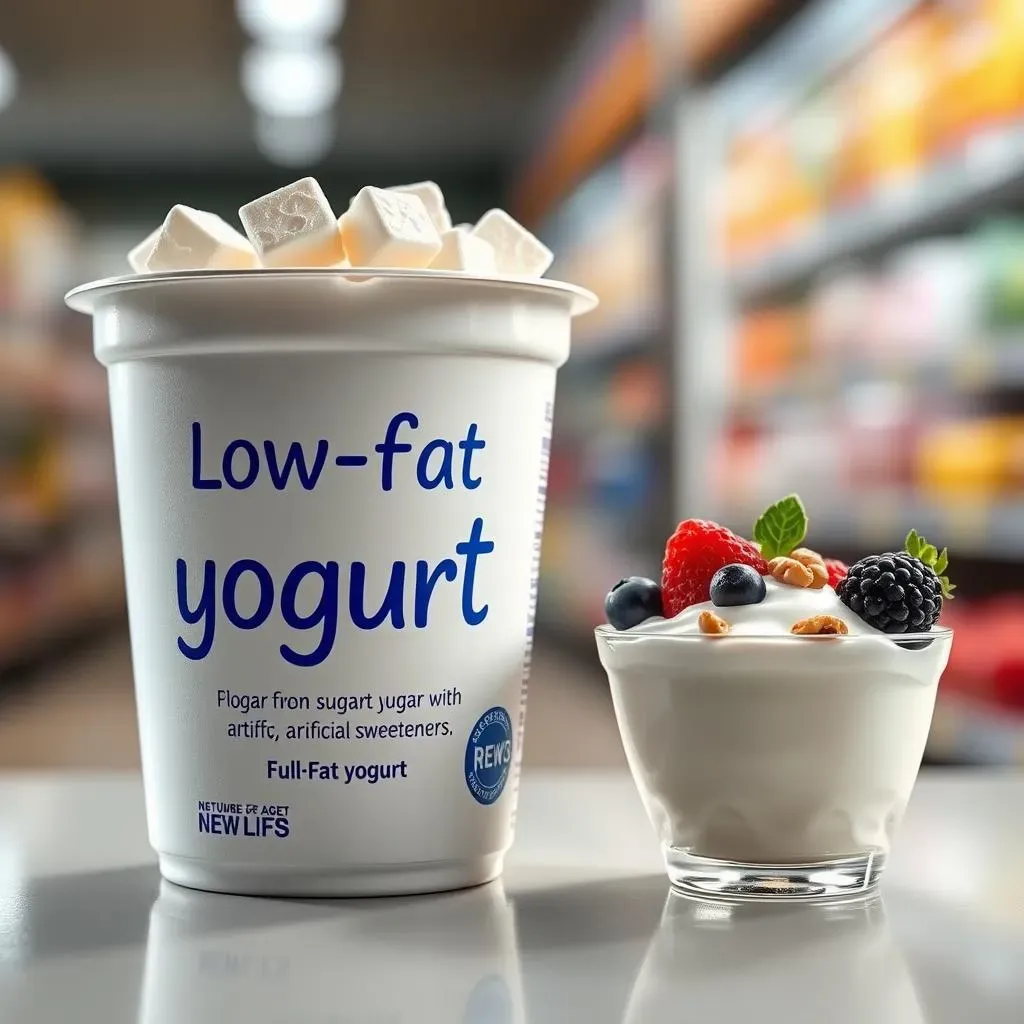Table of Contents
You're staring down the yogurt aisle, trying to make the healthy choice. Low-fat seems like the obvious winner, right? But what if I told you that choosing that seemingly virtuous option could actually be working against your weight loss goals? It sounds counterintuitive, but the question "does low fat yogurt make you gain weight" is more complex than you might think. We're diving deep into the world of yogurt, separating fact from fiction, and uncovering the surprising truth about how different types of yogurt affect your body. Forget everything you thought you knew about low-fat being the ultimate weight-loss weapon. This isn't just about calories; it's about how your body processes different types of fats and sugars, and how those processes impact your appetite and metabolism. We'll explore the sneaky ways low-fat yogurts can be loaded with added sugars, how full-fat options can actually keep you feeling fuller for longer, and ultimately, how to make informed choices that align with your health and weight management goals. Get ready to rethink your yogurt strategy – it's time to get real about what's actually in that little cup.
The LowFat Yogurt Deception: Why You Might Be Gaining Weight

The LowFat Yogurt Deception: Why You Might Be Gaining Weight
The Illusion of Health: Low-Fat Isn't Always Better
We've been conditioned to believe that low-fat equals healthy, especially when it comes to dairy. But here's the kicker: when manufacturers strip out the fat from yogurt, they often compensate by loading it up with sugar, artificial sweeteners, and other additives to improve the taste and texture. Think about it – fat contributes to that creamy, satisfying mouthfeel. Take that away, and you're left with something that tastes, well, kind of bland. So, in comes the sugar to save the day (or so they think).
This is where the "low-fat" deception really takes hold. You might be reaching for that container thinking you're making a virtuous choice, but you could be unknowingly consuming a product that's packed with ingredients that can actually contribute to weight gain. It's like swapping out one problem for another, and sometimes, the "solution" is even worse than the original.
The Calorie Conundrum: Where Are Those Calories Really Coming From?
Here's the thing about calories: they're not all created equal. 100 calories from a piece of fruit will have a different effect on your body than 100 calories from a processed snack. Similarly, the calories in full-fat yogurt, which come primarily from healthy fats and protein, can be more satiating and beneficial than the calories in low-fat yogurt, which often come from added sugars and artificial ingredients.
When you consume a low-fat yogurt that's high in sugar, your blood sugar levels spike, leading to an energy rush followed by a crash. This can leave you feeling hungry and craving more sugary foods, setting off a vicious cycle of overeating and weight gain. On the other hand, the healthy fats in full-fat yogurt can help stabilize blood sugar levels, keeping you feeling fuller for longer and reducing the likelihood of those pesky cravings. So, it's not just about the number of calories; it's about where those calories are coming from and how they're affecting your body.
Yogurt Type | Typical Fat Content | Potential Sugar Content | Impact on Satiety |
|---|---|---|---|
Low-Fat Yogurt | 0-3% | High (often with added sugars) | Low (due to lack of fat and fiber) |
Full-Fat Yogurt | 4-8% | Lower (naturally occurring sugars) | High (due to fat and protein content) |
Unpacking the Sugar Content in LowFat Yogurt: A Hidden Culprit

Unpacking the Sugar Content in LowFat Yogurt: A Hidden Culprit
The Sweet Deception: Added Sugars vs. Natural Sugars
Alright, let's get real about sugar. When we talk about the sugar content in low-fat yogurt, it's crucial to distinguish between naturally occurring sugars (like lactose) and added sugars. Lactose is the sugar naturally found in milk, and it's generally not the main concern. The real culprits are the added sugars – sucrose, high-fructose corn syrup, and other sweeteners – that manufacturers pump into low-fat yogurt to compensate for the lack of flavor and texture.
These added sugars are where the problems begin. They contribute empty calories, spike blood sugar levels, and can lead to insulin resistance over time. Plus, they often trigger cravings for more sugary foods, making it even harder to stick to a healthy diet. It's a vicious cycle that can sabotage your weight loss efforts, even if you think you're making a healthy choice by opting for low-fat yogurt.
Ever wonder what all those different names for sugar actually mean? Here's a quick cheat sheet:
- Sucrose: Plain old table sugar.
- High-Fructose Corn Syrup: A cheap and highly processed sweetener.
- Agave Nectar: Marketed as a "healthy" alternative, but still high in fructose.
- Honey: A natural sweetener, but still contributes to overall sugar intake.
- Maple Syrup: Another natural option, but use it sparingly.
Decoding the Label: How to Spot Hidden Sugars
So, how do you navigate the yogurt aisle and avoid the sugar trap? The key is to become a label-reading pro. Start by checking the "Added Sugars" on the nutrition facts panel. This will give you a clear picture of how much sugar has been added to the yogurt beyond the naturally occurring lactose. Aim for yogurts with little to no added sugars, or those that use natural sweeteners like stevia or monk fruit in moderation.
Also, pay attention to the ingredient list. Look out for sneaky names for sugar, like those listed above. The closer these ingredients are to the beginning of the list, the more of them the yogurt contains. Don't be fooled by marketing claims like "naturally flavored" or "fruit on the bottom" – these often mask a high sugar content. A little detective work can go a long way in making a truly healthy yogurt choice.
Here's a handy table to help you compare sugar content in different yogurt types:
Yogurt Type | Typical Sugar Content (per serving) | Key Considerations |
|---|---|---|
Plain, Unsweetened Yogurt | 5-10 grams (lactose) | Best option; control sugar content yourself |
Low-Fat Flavored Yogurt | 15-25+ grams (added sugars) | Often loaded with added sugars; read labels carefully |
Greek Yogurt (Plain) | 5-8 grams (lactose) | Higher protein content; choose unsweetened |
Full-Fat Flavored Yogurt | 10-20 grams (added sugars) | Can be a better option than low-fat if lower in sugar |
FullFat vs. LowFat: Understanding the Impact on Satiety and Calorie Intake

FullFat vs. LowFat: Understanding the Impact on Satiety and Calorie Intake
The Satiety Factor: Why Fat Keeps You Full
let's talk about satiety – that feeling of fullness and satisfaction after eating. It's a crucial factor in weight management because it helps you eat less overall. And guess what? Fat plays a major role in satiety. When you consume fat, it triggers the release of hormones that signal to your brain that you're full and satisfied. This can help you avoid overeating and keep those cravings at bay.
Think about it: a small handful of nuts, which are high in healthy fats, can often keep you feeling satisfied for hours. Now, compare that to a low-fat snack, like a rice cake, which might give you a quick energy boost but leaves you feeling hungry again soon after. The difference lies in the fat content and its impact on your satiety hormones. So, when it comes to yogurt, opting for full-fat versions can actually help you eat less in the long run by keeping you feeling fuller for longer.
Calorie Density: It's Not Just About the Numbers
Calorie density refers to the number of calories per gram of food. Foods with a high calorie density pack a lot of calories into a small volume, while foods with a low calorie density provide fewer calories per gram. Full-fat yogurt has a higher calorie density than low-fat yogurt, but that doesn't necessarily make it the enemy. In fact, the higher fat content can actually work in your favor.
Because fat is more satiating, you're likely to eat less of a high-calorie-density food like full-fat yogurt than you would of a low-calorie-density food like low-fat yogurt. Plus, the healthy fats in full-fat yogurt can help improve nutrient absorption and support hormone production. So, while it's important to be mindful of calorie intake, it's equally important to consider the nutrient density and satiety factor of the foods you're eating. Choosing full-fat yogurt over low-fat might actually lead to a lower overall calorie intake due to its impact on satiety.
Factor | Full-Fat Yogurt | Low-Fat Yogurt |
|---|---|---|
Satiety | Higher (due to fat content) | Lower (lack of fat) |
Calorie Density | Higher | Lower |
Potential Sugar Content | Lower (naturally occurring sugars) | Higher (often with added sugars) |
Impact on Overall Calorie Intake | Potentially lower (due to increased satiety) | Potentially higher (due to decreased satiety and sugar cravings) |
The Role of Dairy in Weight Management: Is LowFat Always Better?

The Role of Dairy in Weight Management: Is LowFat Always Better?
Dairy's Double-Edged Sword: Benefits and Potential Pitfalls
Dairy has always been a bit of a nutritional battleground. On one side, you've got the calcium, vitamin D, and protein – all essential for bone health, muscle building, and overall well-being. On the other, there's the saturated fat content, which has been demonized for years (though, as we're learning, the story is more nuanced than we once thought). So, where does dairy fit into a healthy weight management plan? The answer, as with most things in nutrition, isn't black and white.
The key is to consider the whole picture. Are you choosing dairy products that are loaded with added sugars and artificial ingredients, or are you opting for plain, unsweetened options that provide a good source of nutrients without the unnecessary extras? Are you looking at the sugar content of yogurt, or other additives? It's about making informed choices and understanding how different types of dairy can impact your body. Don't get sucked into the low-fat = healthy trap. Instead, focus on real food, balanced nutrition, and listening to your body's signals.
The Full-Fat Comeback: Rethinking Saturated Fat
For years, we've been told to fear saturated fat like the plague. But recent research is challenging that conventional wisdom, suggesting that saturated fat may not be as detrimental to our health as we once thought. In fact, some studies have even shown that full-fat dairy may be associated with a lower risk of obesity and type 2 diabetes. It's not a license to go wild with butter and cheese, but it does suggest that we need to rethink our relationship with saturated fat.
One possible explanation is that the saturated fat in full-fat dairy helps improve satiety and regulate blood sugar levels, leading to reduced cravings and better overall calorie control. Another is that the fat-soluble vitamins in dairy (like vitamins A, D, E, and K) are better absorbed when consumed with fat. Plus, full-fat dairy often contains conjugated linoleic acid (CLA), a type of fat that has been linked to various health benefits, including improved body composition. So, before you automatically reach for the low-fat option, consider the potential benefits of full-fat dairy and how it might fit into your overall diet.
Consideration | Low-Fat Dairy | Full-Fat Dairy |
|---|---|---|
Nutrient Density | Can be lower (fat-soluble vitamins may be less bioavailable) | Higher (better absorption of fat-soluble vitamins) |
Satiety | Lower (less fat, often more sugar) | Higher (more fat, potential for better blood sugar control) |
Potential Health Benefits | May be lower if highly processed and full of added sugars | May be associated with lower risk of obesity and type 2 diabetes (in some studies) |
Making Informed Choices: Balancing Yogurt Consumption for a Healthy Diet

Making Informed Choices: Balancing Yogurt Consumption for a Healthy Diet
Finding Your Yogurt Sweet Spot: It's All About Balance
so we've debunked the myth that low-fat yogurt is always the healthier choice. Now what? How do you actually incorporate yogurt into a balanced diet without sabotaging your weight loss goals? The key, as with most things, is balance. It's about finding the right type of yogurt, the right portion size, and the right combination of toppings and add-ins to create a snack or meal that's both satisfying and nutritious.
Think of yogurt as a blank canvas. You can dress it up or down depending on your needs and preferences. Start with a base of plain, unsweetened yogurt (either Greek or regular, full-fat or low-fat – the choice is yours). Then, add your own flavors and nutrients with things like fresh fruit, nuts, seeds, and a touch of honey or maple syrup (if needed). This way, you're in control of the sugar content and can tailor the yogurt to your specific dietary needs.
Portion Control: How Much Is Too Much?
Even with the healthiest yogurt choices, portion control is still crucial. It's easy to overdo it, especially when you're dealing with something as tasty and versatile as yogurt. A typical serving size is about ¾ cup (6 ounces), but this can vary depending on the type of yogurt and your individual calorie needs. Pay attention to the nutrition facts label and adjust your portion size accordingly.
Also, be mindful of what you're adding to your yogurt. A handful of nuts and seeds can quickly add up in calories, as can a drizzle of honey or maple syrup. Measure out your toppings and add-ins carefully to avoid overdoing it. It's all about being mindful and making conscious choices that align with your goals. Don't just mindlessly spoon yogurt into your mouth – savor each bite and pay attention to your body's satiety signals.
Yogurt Component | Portion Size | Key Considerations |
|---|---|---|
Plain Yogurt (Greek or Regular) | ¾ cup (6 ounces) | Adjust based on calorie needs; full-fat or low-fat is your choice |
Fresh Fruit | ½ cup | Berries are a great low-sugar option |
Nuts and Seeds | 1-2 tablespoons | Measure carefully; high in calories |
Natural Sweeteners (Honey, Maple Syrup) | 1-2 teaspoons | Use sparingly; they still impact blood sugar |
Listen to Your Body: Finding What Works for You
Ultimately, the best way to balance yogurt consumption for a healthy diet is to listen to your body. Pay attention to how different types of yogurt make you feel. Do you feel satisfied and energized after eating full-fat yogurt, or do you experience digestive discomfort? Does low-fat yogurt leave you feeling hungry and craving more sugary foods, or does it help you stay on track with your calorie goals? Everyone's body is different, and what works for one person might not work for another.
Experiment with different types of yogurt, toppings, and portion sizes to find what feels best for you. Keep a food journal to track your intake and note how you feel after eating different combinations. Don't be afraid to adjust your approach as needed. The goal is to find a sustainable and enjoyable way to incorporate yogurt into your diet that supports your overall health and well-being. And remember, it's not about perfection – it's about progress.
The Final Scoop: Making Yogurt Work For You
So, does low fat yogurt make you gain weight? The answer, as we've seen, isn't a simple yes or no. It's about understanding the whole picture: the sugar content, the satiety factor, and your overall dietary habits. While low-fat options might seem like the obvious choice, they can sometimes be a sneaky source of added sugars and may not keep you feeling full for long. Full-fat yogurt, on the other hand, can be a more satisfying and potentially beneficial option when consumed in moderation as part of a balanced diet. Ultimately, the best yogurt for you is one that you enjoy, that fits into your calorie goals, and that helps you feel your best. Read the labels, be mindful of added sugars, and listen to your body. Yogurt can be a fantastic part of a healthy lifestyle – just make sure you're choosing wisely.
